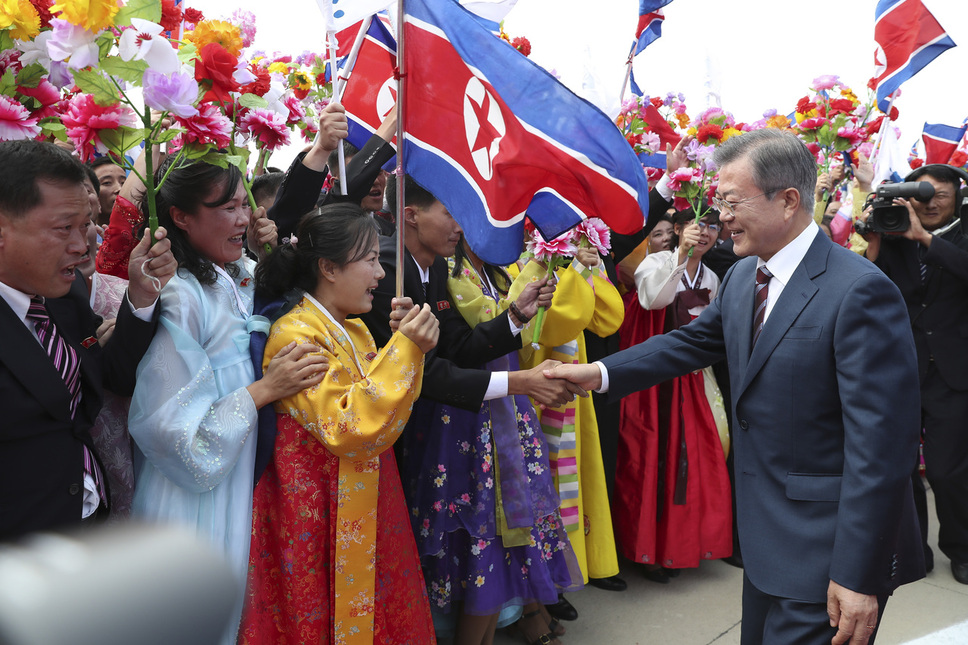 |
|
South Korean President Moon Jae-in shakes hands with Pyongyang residents after being greeting by North Korean leader Kim Jong-un at Pyongyang Sunan International Airport on Sept. 18. (photo pool)
|
Withdrawal of DMZ guard posts and demilitarization of JSA possible measures
The prevention of unintended clashes and reduction of military tensions between South and North Korea will be key issues at the inter-Korean summit in Pyongyang, which is focused on the theme of “peace and a new future.” Clause 2 of the Panmunjom Declaration issued on Apr. 27 by the South and North Korea heads of state clarifies their agreement to “completely cease all hostile acts against each other in every domain, including land, air and sea.” On that basis, South and North Korean authorities have been discussing implementation plans through two rounds of military general-level talks, working-level talks, and document exchanges. “We’re in the final stages of working-level discussions with the North toward a comprehensive agreement concerning different military areas,” a Ministry of National Defense senior official said. “Once agreed upon, items are either to be included in the summit agreement text or developed into agreements between the Ministry of National Defense and [North Korea] Ministry of People’s Armed Forces,” the official added. Among the areas to be discussed at the summit are the joint inter-Korean excavation of human remains in the Demilitarized Zone (DMZ), the withdrawal of DMZ guard posts, a suspension of hostile activities on the West (Yellow) Sea, and demilitarization of the Joint Security Area (JSA) at Panmunjom. The joint excavation of remains “should not present any major difficulties for negotiations since it is an area North Korea also agrees on,” a military official said. The two sides plan to conduct a pilot effort for one selected region within the DMZ with easy access and a large number of war dead. The withdrawal of DMZ guard posts is also to be expanded following a pilot effort. The idea of withdrawing guard posts was first suggested by then-President Roh Moo-hyun during an inter-Korean summit in Oct. 2007. Then-North Korean leader Kim Jong-il reportedly balked at the time, saying that he “supported” the idea but calling it “premature.” Current discussions are reportedly focusing on the initial withdrawal of around ten guard posts located within relatively short distances between South and North. A suspension of hostile activities on the West Sea is already partially under way. The Baengnyeong Island live-fire drills typically staged in July and August by South Korea were not conducted this year; in July, communication between South and North Korean warships was restored for the first time in ten years through the global merchant marine network. But the two sides are reportedly still experiencing differences on the establishment of a “maritime peace zone,” which is tied to North Korea’s recognition of South Korea’s Northern Limit Line (NLL). Demilitarization of the Panmunjom JSA was proposed by the North Korean side. Although principle dictates that the JSA is not to be armed with any weapons besides handguns, the site is actually armed with rifles and machine guns as well. Negotiations between the two sides are taking place under discussions with the UN Command, which has jurisdiction over the JSA. North Korea is also reported to have proposed establishing a no-fly zone covering 40 to 60km on either side of the Military Demarcation Line (MDL). South Korea currently has a no-fly zone in place within five miles (8km) to the south of the MDL. If the zone is expanded to 40–60km as suggested by the North, military aircraft will no longer be able to fly in the skies north of Seoul. “If the no-fly zone is broadened, this will affect reconnaissance aircraft gathering imagery intelligence on North Korea,” a military official said. Military authorities are reportedly in discussions with North Korea on a range that would not negatively impact operations. South and North Korea are also reportedly discussing the operation of a joint military committee. The two sides previously agreed to establish a joint military committee in their Basic Agreement of Dec. 1991, but it was never launched as inter-Korean relations broke down the following year with the resumption of the Team Spirit exercises. “If South and North do agree to operate a joint military committee, it will be a consultative body staffed at the vice minister level,” a military official said. By Park Byong-su, senior staff writer Please direct comments or questions to [english@hani.co.kr]






